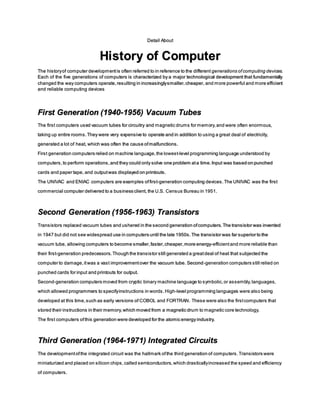
History of Computer Generations
- 1. Detail About History of Computer The historyof computer developmentis often referred to in reference to the different generations ofcomputing devices. Each of the five generations of computers is characterized by a major technological development that fundamentally changed the way computers operate,resulting in increasinglysmaller,cheaper, and more powerful and more efficient and reliable computing devices First Generation (1940-1956) Vacuum Tubes The first computers used vacuum tubes for circuitry and magnetic drums for memory,and were often enormous, taking up entire rooms.They were very expensive to operate and in addition to using a great deal of electricity, generated a lot of heat, which was often the cause ofmalfunctions. First generation computers relied on machine language,the lowest-level programming language understood by computers,to perform operations,and they could only solve one problem ata time.Input was based on punched cards and paper tape, and outputwas displayed on printouts. The UNIVAC and ENIAC computers are examples offirst-generation computing devices.The UNIVAC was the first commercial computer delivered to a business client, the U.S. Census Bureau in 1951. Second Generation (1956-1963) Transistors Transistors replaced vacuum tubes and ushered in the second generation ofcomputers.The transistor was invented in 1947 but did not see widespread use in computers until the late 1950s.The transistor was far superior to the vacuum tube, allowing computers to become smaller,faster,cheaper,more energy-efficientand more reliable than their first-generation predecessors.Though the transistor still generated a greatdeal of heat that subjected the computer to damage,itwas a vast improvementover the vacuum tube. Second-generation computers still relied on punched cards for input and printouts for output. Second-generation computers moved from cryptic binary machine language to symbolic,or assembly,languages, which allowed programmers to specifyinstructions in words. High-level programming languages were also being developed at this time,such as early versions of COBOL and FORTRAN. These were also the firstcomputers that stored their instructions in their memory,which moved from a magnetic drum to magnetic core technology. The first computers ofthis generation were developed for the atomic energy industry. Third Generation (1964-1971) Integrated Circuits The developmentofthe integrated circuit was the hallmark ofthe third generation of computers.Transistors were miniaturized and placed on silicon chips,called semiconductors,which drasticallyincreased the speed and efficiency of computers.
- 2. Instead of punched cards and printouts,users interacted with third generation computers through keyboards and monitors and interfaced with an operating system,which allowed the device to run many different applications atone time with a central program thatmonitored the memory.Computers for the firsttime became accessible to a mass audience because theywere smaller and cheaper than their predecessors. Fourth Generation (1971-Present) Microprocessors The microprocessor broughtthe fourth generation ofcomputers,as thousands ofintegrated circuits were builtonto a single silicon chip.Whatin the first generation filled an entire room could now fit in the palm of the hand. The Intel 4004 chip, developed in 1971, located all the components ofthe computer—from the central processing unitand memoryto input/outputcontrols—on a single chip. In 1981 IBM introduced its firstcomputer for the home user,and in 1984 Apple introduced the Macintosh. Microprocessors also moved outof the realm ofdesktop computers and into manyareas oflife as more and more everyday products began to use microprocessors. As these small computers became more powerful,they could be linked together to form networks,which eventually led to the developmentofthe Internet. Fourth generation computers also saw the developmentof GUIs, the mouse and handheld devices. Fifthgenerationcomputer The Fifth Generation Computer Systems project (FGCS) was an initiative by Japan's Ministry of International Trade and Industry, begun in 1982, to create a computer using massively parallel computing/processing. It was to be the result of a massive government/industry research project in Japan during the 1980s. It aimed to create an "epoch-making computer" with-supercomputer- like performance and to provide a platform for future developments in artificial intelligence. There was also an unrelated Russian project also named as fifth-generation computer (see Kronos (computer)).The term "fifth generation" was intended to convey the system as being a leap beyond existing machines. In the history of computing hardware, computers using vacuum tubes were called the first generation; transistors and diodes, the second; integrated circuits, the third; and those using microprocessors, the fourth. Whereas previous computer generations had focused on increasing the number of logic elements in a single CPU, the fifth generation, it was widely believed at the time, would instead turn to massive numbers of CPUs for added performance. The project was to create the computer over a ten-year period, after which it was considered ended and investment in a new "sixth generation" project would begin. Opinions about its outcome are divided: either it was a failure, or it was ahead of its time.
